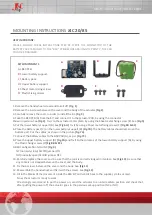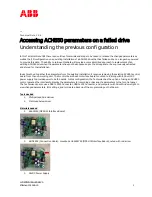
40
WILO SE 10/2022 V05 DIN A4
English INSTALLATION
5.2.
Installation types
DANGER due to units falling over!
Vertical installation may only be carried out
for units up to 7.5 kW. If the unit falls over,
there is a risk of injury!
NOTICE
Horizontal dry well installation: only products
with “...H...”
Vertical dry well installation: only products with
“...V...” ≤ 7.5 kW
5.3.
Installation
NOTICE
Also note all the information regarding installa-
tion in the operating and maintenance manual
from the motor manufacturer!
The following information should be taken into consideration
when installing the hydraulics:
•
This work must be performed by qualified personnel
and electrical work must be performed by a qualified
electrician.
• The operating space must be clean, dry and free from
frost, and designed for the hydraulics in question.
• When working in pump chambers, a second person
must be present for safety reasons. Take the necessary
countermeasures if there is a risk of toxic or suffocating
gases collecting!
•
Ensure that lifting equipment can be fitted without any
trouble, since this is required for the installation and
dismantling of the hydraulics. It must be possible to
reach the hydraulics safely in their operating and storage
locations using the lifting equipment. The set-down
location must have a solid bearing surface. For trans-
porting the hydraulics, the lifting gear must be secured
to the prescribed attachment points. When using chains,
these must be connected to the attachment point using
a shackle. The lifting gear used must be technically
approved.
• The structural components and foundations must be of
sufficient stability in order to allow the product to be
fixed securely and properly. The operator or the supplier
is responsible for providing the foundations and their
suitability in terms of dimensions, stability and strength!
•
For vertical dry well installation, there must be a fixation
to the foundation.
•
Flange foot arch (Fig. 3b)
•
Holder with flange connection for the hydraulics
provided by the customer
• Never let the hydraulics run dry. Air pockets are to be
avoided at all costs. Appropriate ventilation systems
must be provided.
• Check that the available consulting documents (installa-
tion plans, layout of the operating space, inlet condi-
tions) are complete and correct.
• Also refer to all regulations, rules and laws for work-
ing with heavy and suspended loads. Wear appropriate
protective clothing.
• Please also observe the applicable national accident
prevention and safety regulations of professional and
trade associations.
5.3.1. Attachment points
To raise and lower the hydraulics, they must be fastened
at the specified attachment points. We differentiate here
between the unit and the “bare shaft” version.
Fig. 2.: Attachment points
A “Bare shaft” version (horizontal)
B Unit (hori vertical)
1 Transport shackle (horizontal)
2 Lifting eye (vertical)
Definition of symbols
Attach here!
Shackle must be used!
Lifting equipment: Chain permitted
Lifting equipment: Wire rope or nylon rope
permitted
Lifting equipment: Transport strap permitted
Use of a hook for attachment is prohibited!
Use of chains as lifting equipment prohibited
The following information must be observed when attaching
the lifting equipment:
Horizontal installation:
• The lifting equipment must be fastened to the transport
shackle by a shackle. Carrying straps, wire ropes and
plastic ropes or chains may be used as lifting equipment.
• The transport shackle must be dismantled after posi-
tioning is complete.
• When attached to the housing parts, the lifting equip-
ment must be fastened in a loop. Chains may
not
be
used here!
Vertical installation:
• Units for vertical installation are delivered horizontally
and lifted at the lifting eyes (Fig. 2, Item 2).
• Attach the lifting equipment to all 4 lifting eyes by
means of shackles. Carrying straps, wire ropes and plas-
tic ropes or chains may be used as lifting equipment.
















































